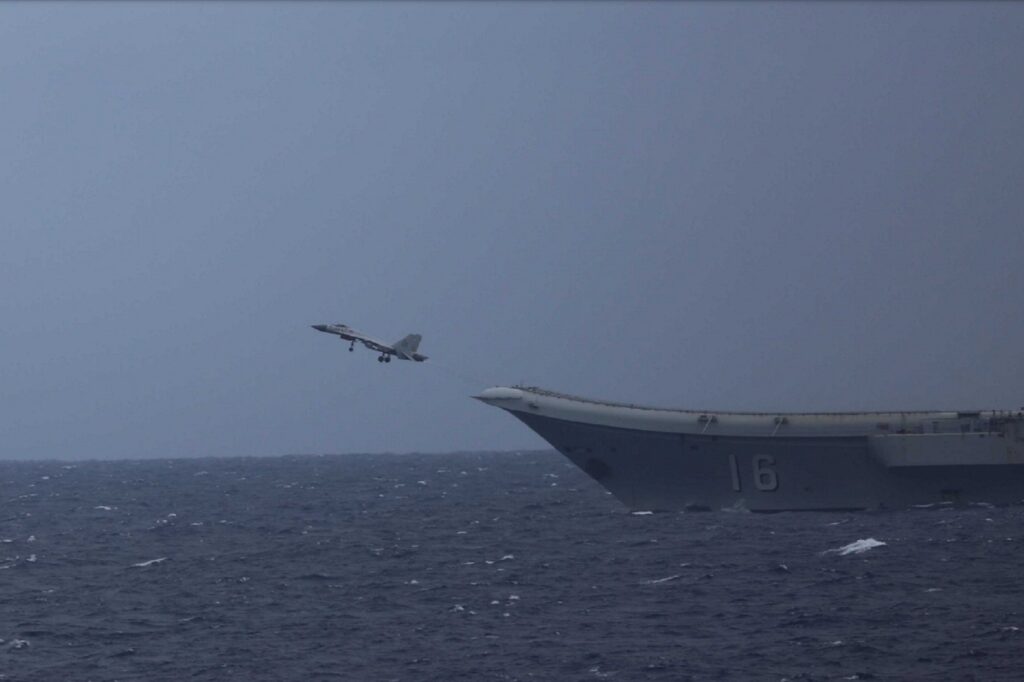Japan’s Defense Ministry reported that a carrier battle group formed around China’s aircraft carrier CNS Liaoning sailed through the Miyako Strait between two islands of the Okinawa Prefecture on December 16, 2022.
In addition to the CNS Liaoning, China’s People’s Liberation Army Navy (PLAN) carrier battle group included two Type 055 Renhai-class guided-missile destroyers. First commissioned in 2020, these stealth vessels are expected to form the bulk of China’s carrier escorts in the future.
Once it reached the western Pacific Ocean, the carrier group reportedly held drills, with Japan observing multiple fighters and helicopters taking off and landing on the CNS Liaoning. Fighter jets of the Japanese Air Self-Defense Force were scrambled to monitor the situation.
No airspace incursion was reported. However, on the morning of December 19, 2022, the Japanese Defense Ministry said that a Type 636A Shupang-class hydrographic survey ship entered Japan’s territorial waters south of Yakushima island, near the island of Kyushu. A Kawasaki P-1 maritime patrol aircraft of Japan’s Maritime Self-Defense Force 1st Air Group shadowed the vessel until it left the area.
A reaction to Japan’s new defense posture?
This show of force by the PLAN coincided with the release of a new National Security Strategy (NSS) by Japan on December 15, 2022. According to this new doctrine, Japan intends to acquire counter-attack capabilities.
“We live in the world of a historical inflection point and in the face of the most severe and complex security environment since the end of WWII,” the new NNS outlines, while referring to increased activities of North Korea, China and Russia in Japan’s Area of Security. “A key to deterring invasion against Japan is counterstrike capabilities that leverage stand-off defense capability and other capabilities.”
In its annual budget request published on August 31, 2022, the Japanese Ministry of Defense had already called for the development of new long-range missiles and upgrade existing ones to bolster its stand-off defense capability. The proposed budget included the development of high-velocity glide missiles and hypersonic guided missiles.
China’s increased presence in blue waters
This is the second time this year that the Liaoning carrier battle group sails in the vicinity of Japan. In May 2022, the aircraft carrier crossed the Miyako Strait to the Western Pacific with a smaller escort. Over six days, the J-15 fighters aboard the CNS Liaoning conducted more than a hundred sorties near Okinawa.
At the time, Japan dispatched the JS Izumo helicopter carrier, the largest warship in the Japanese navy since the Second World War, to monitor China’s naval and air activities in the area. This move was denounced by China’s Ministry of National Defense whose spokesperson, Colonel Wu Qian, said the close-range tracking and ensuing disruptions by the Japanese military were very dangerous and could have led to accidents.
Designated Type 001, the Liaoning aircraft carrier is capable of carrying 40 aircraft including a wing of 26 J-15 fighter jets, the Chinese version of the Russian Su-33. Commissioned by the PLAN in 2012, it was followed by the CNS Shandong in 2019 and the CNS Fujian in 2022. This aggressive fleet expansion demonstrates China’s ambition to not only defend its neighboring waters but also project its forces on a global scale.
In parallel, China is also reportedly developing a new carrier-borne fighter jet to replace the aging J-15 fighters. Called the J-35 fifth-generation fighter jet, the aircraft would be based on the Shenyang FC-31 “Gyrfalcon” rejected by the People’s Liberation Army Air Force (PLAAF). Featured prominently during the 2021 Zhuhai Airshow, it was however absent from its 2022 edition.

